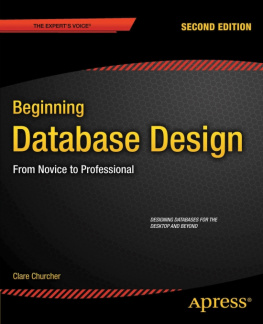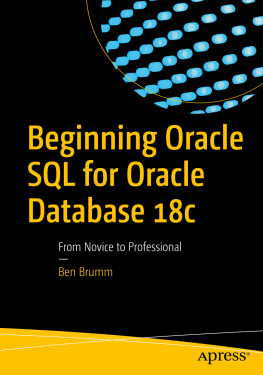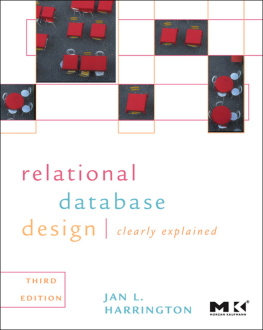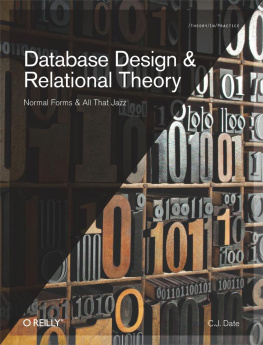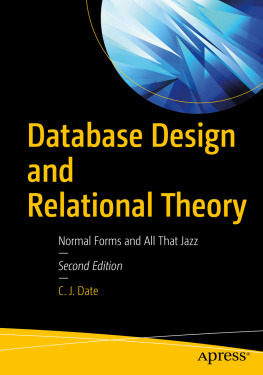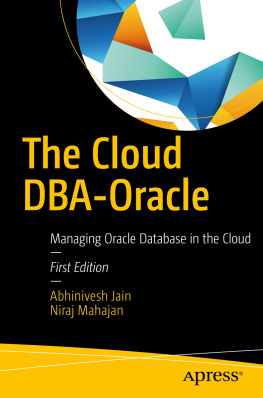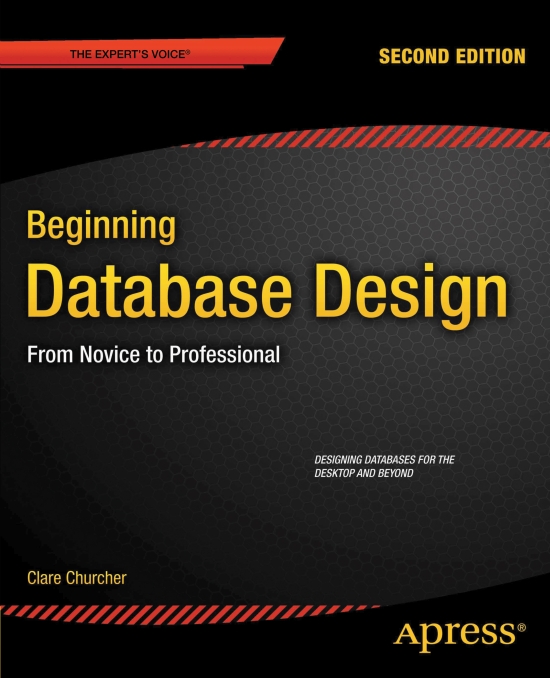
Beginning Database Design
Beginning Database Design

Clare Churcher

Beginning Database Design: From Novice to Professional
Copyright 2012 by Clare Churcher
This work is subject to copyright. All rights are reserved by the Publisher, whether the whole or part of the material is concerned, specifically the rights of translation, reprinting, reuse of illustrations, recitation, broadcasting, reproduction on microfilms or in any other physical way, transmission or information storage and retrieval, electronic adaptation, adaptation to computer software, or by similar or dissimilar methodology now known or hereafter developed. Exempted from this legal reservation are brief excerpts in connection with reviews or scholarly analysis, or material supplied specifically for the purpose of being entered and executed on a computer system, for exclusive use by the purchaser of the work. Duplication of this publication or parts thereof is permitted only under the provisions of the Copyright Law of the Publisher's location, in its current version, and permission for use must always be obtained from Springer. Permissions for use may be obtained through RightsLink at the Copyright Clearance Center. Violations are liable to prosecution under the respective Copyright Law.
ISBN-13 (pbk): 978-1-4302-4209-3
ISBN-13 (electronic): 978-1-4302-4210-9
Trademarked names, logos, and images may appear in this book. Rather than use a trademark symbol with every occurrence of a trademarked name, logo, or image we use the names, logos, and images only in an editorial fashion and to the benefit of the trademark owner, with no intention of infringement of the trademark.
The use in this publication of trade names, trademarks, service marks, and similar terms, even if they are not identified as such, is not to be taken as an expression of opinion as to whether or not they are subject to proprietary rights.
While the advice and information in this book are believed to be true and accurate at the date of publication, neither the authors nor the editors nor the publisher can accept any legal responsibility for any errors or omissions that may be made. The publisher makes no warranty, express or implied, with respect to the material contained herein.
President and Publisher: Paul Manning
Lead Editor: Jonathan Gennick
Technical Reviewer: Stphane Faroult
Editorial Board: Steve Anglin, Ewan Buckingham, Gary Cornell, Louise Corrigan, Morgan Ertel, Jonathan Gennick, Jonathan Hassell, Robert Hutchinson, Michelle Lowman, James Markham, Matthew Moodie, Jeff Olson, Jeffrey Pepper, Douglas Pundick, Ben Renow-Clarke, Dominic Shakeshaft, Gwenan Spearing, Matt Wade, Tom Welsh
Coordinating Editor: Anita Castro
Copy Editor: Chandra Clarke
Compositor: SPi Global
Indexer: SPi Global
Artist: SPi Global
Cover Designer: Anna Ishchenko
Distributed to the book trade worldwide by Springer Science+Business Media New York, 233 Spring Street, 6th Floor, New York, NY 10013. Phone 1-800-SPRINGER, fax (201) 348-4505, e-mail .
For information on translations, please e-mail .
Apress and friends of ED books may be purchased in bulk for academic, corporate, or promotional use. eBook versions and licenses are also available for most titles. For more information, reference our Special Bulk SaleseBook Licensing web page at www.apress.com/bulk-sales.
Any source code or other supplementary materials referenced by the author in this text are available to readers at www.apress.com. For detailed information about how to locate your books source code, go to www.apress.com/source-code.
To Neville
Contents at a Glance













Contents













Foreword
When I wrote the foreword to the first edition of Beginning Database Design, I expressed my hopes to see this book become a popular classic. I felt that it deserved to be so. As the technical reviewer, I had thoroughly enjoyed Clares skill in turning a subject that is often presented dryly into a vivid and interesting book, and her skill in dissecting the thought process that lets you go from functional requirements to the design of a database that will be able to keep data consistent, grow, and bear the load. Beginning Database Design doesnt enunciate, like so many books, quasidivine rules with pretentious jargon. It explains the goals, the common mistakes, why they are mistakes, and what you should do instead. It brings to light the logic behind the rules, all in a short and very readable book.
There is much satisfaction in seeing five years later that my hopes have been fulfilled, and that Beginning Database Design has become one of the leading titles on this important topicdatabases are everywhere and database design belongs to the core body of knowledge of any serious software developer. This edition has retained all the qualities that made the first one successful, including Clares lucid writing and humor, and if the page count has increased it has mostly been to include exercises allowing readers to test their understanding and compare their solutions to the answers that are provided. As the technical reviewer once again, I was in a privileged position to witness the small improvementsthere wasnt that much to improvethat Clare has brought to her book, clarifying a sentence here, improving an example there. There is a great quote by Saint-Exupry, the author of
Next page
